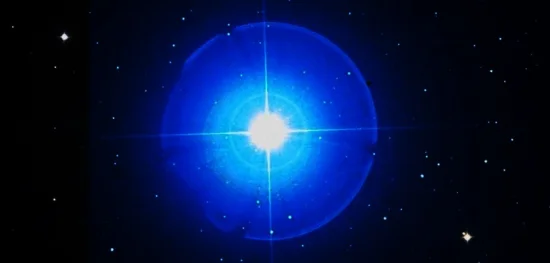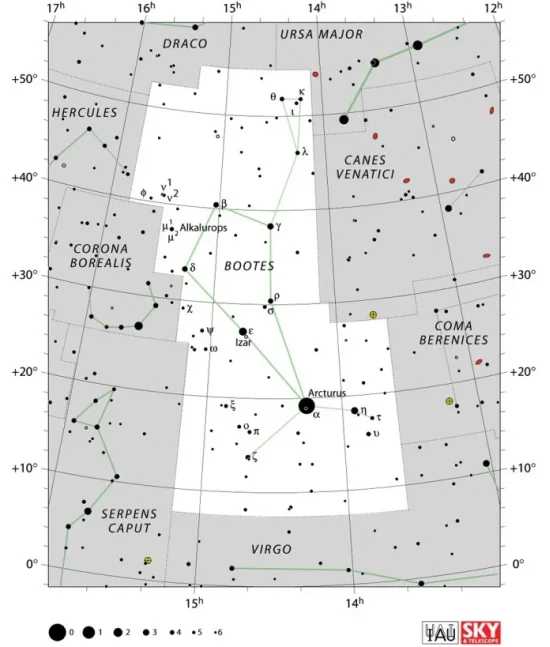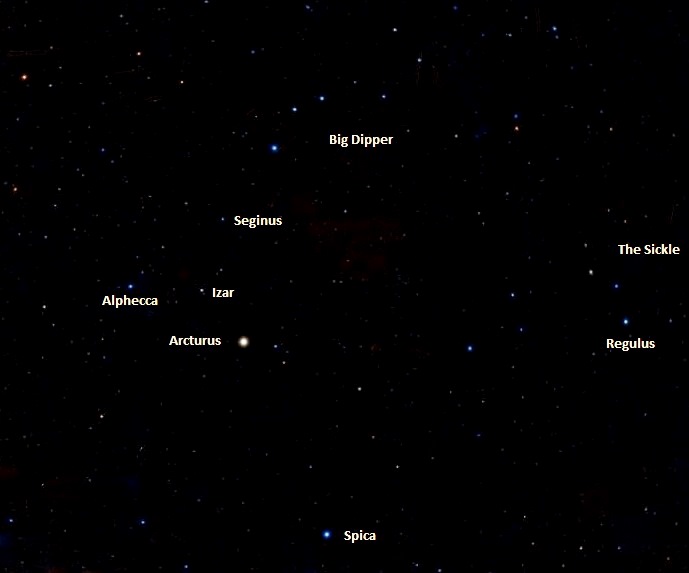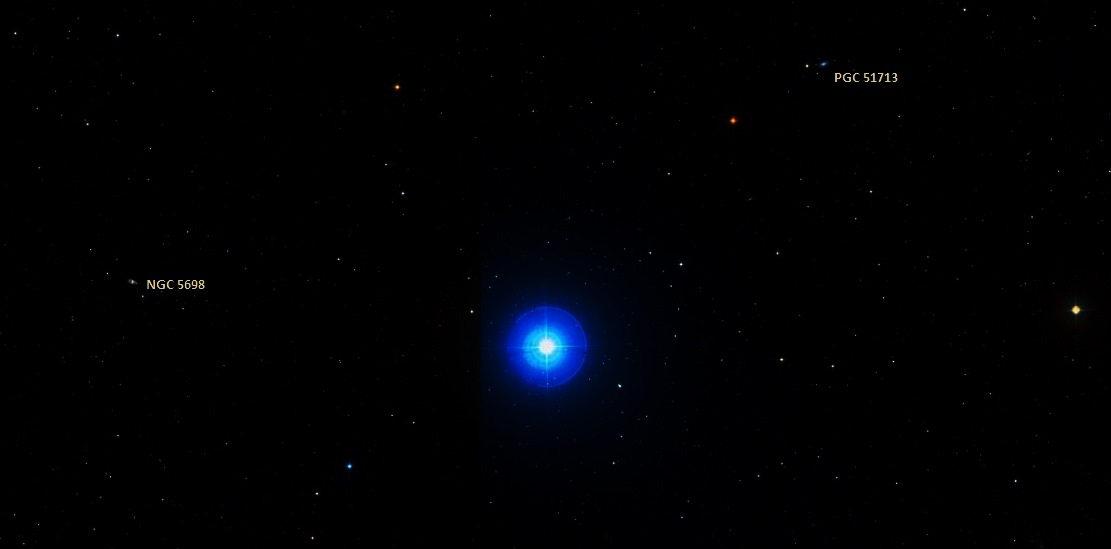Seginus, Gamma Boötis (γ Boo) is a double star located in the constellation Boötes, the Herdsman. With an apparent magnitude of 3.03, it is the fourth brightest star in Boötes, after Arcturus, Izar, and Muphrid. It lies at a distance of 86.3 light years from Earth.
Star system
Gamma Boötis is the primary component of a double star system that also consists of the star UCAC2 45176266. The star system is designated WDS J14321+3818 and the two components are referred to as component A and B.
The two components of Gamma Boötis itself are designated WDS J14321+3818Aa and WDS J14321+3818Ab. The Aa component has the proper name Seginus.
Gamma Boötis has the spectrum of a bluish-white giant star of the spectral type A7 III. It has a radius 3.5 times that of the Sun. With an effective temperature of 7,800 K, it shines with 34 solar luminosities. The star is a fast spinner, with a projected rotational velocity of 140 km/s.

Seginus (Gamma Boötis),image: Wikisky
Seginus is classified as a Delta Scuti variable, a variable star whose brightness fluctuates as a result of both radial and non-radial pulsations of its surface. This means that the star expands and contracts, changing its radius to maintain the spherical shape (radial pulsations), and some parts of its surface move inwards, while others simultaneously move outwards (non-radial pulsations). Seginus has a period of 1.13 hours.
Facts
In early Arabic astronomy, Seginus was part of an asterism known as Al Dhi’bah, meaning “female wolves” or hyenas,” together with Nekkar (Beta Boötis), Delta Boötis, and Alkalurops (Mu Boötis).
Name
The name Seginus (pronunciation: /sɪˈdʒaɪnəs/) has an uncertain origin, but may come from Latinisation of an Arabic form of Theguius, the Greek name for Boötes constellation. It has also been spelled Segin and Ceginus.
The name was officially approved by the International Astronomical Union’s (IAU) Working Group on Star Names (WGSN) on August 21, 2016. It formally applies only to the component Gamma Boötis Aa.
The Chinese know the star as 招搖 (Zhāo Yáo), or Twinkling Indicator. In Chinese astronomy, Seginus is the only star in the asterism known as Twinkling Indicator, which is part of the Chinese Root mansion.
Roman author Marcus Manilius (1st century CE) called the star prona Lycaonia, meaning “sloping towards Lycaon.” The name Lycaonia referred to Ursa Major, the Great Bear, which was associated with Callisto, who was turned into a bear by Hera. Callisto was the daughter of the Arcadian King Lycaon and sometimes known as Lycaonia. The constellation Boötes was called Lycaon.
The 17th century Egyptian astronomer Al Achsasi al Mouakket listed Seginus as Menkib al Aoua al Aisr, meaning “the left shoulder of the barker.” The name was later translated into Latin as Humerus Sinister Latratoris.
The 20th century Czech astronomer Antonín Bečvář listed Gamma Boötis as Haris. The name comes from the Arabic Al-Haris Al-Sama, meaning “the guard of the north” and refers to the constellation Boötes.
Location
Seginus is relatively easy to identify because it is one of the stars that form the Kite asterism that dominates the Boötes constellation. The star lies in the region of the sky between the handle of the Big Dipper and the brighter Boötes stars Arcturus and Izar.
Seginus lies in the vicinity of two spiral galaxies, NGC 5698 and PGC 51713. NGC 5698 hosted a supernova that was observed in 2005 and designated SN 2005bc. The galaxy has an apparent magnitude of 13.8, while PGC 51713 is slightly brighter at magnitude 13.0.
Constellation
Seginus is located in the constellation Boötes. Representing the celestial Herdsman, Boötes is the 13th largest constellation in the sky. It is one of the Greek constellations, first listed in the Greco-Roman astronomer Ptolemy’s Almagest in the 2nd century CE, but has been known long before Ptolemy’s time. It was first mentioned by its name in Homer’s Odyssey. Seginus marks the Herdsman’s left shoulder.
Boötes contains several stars that are popular targets for stargazers, among others the bright Arcturus (Alpha Boötis), the brightest star in the northern celestial hemisphere, and the multiple stars Izar (Epsilon Boötis) and Alkalurops (Mu Boötis).

Boötes constellation map by IAU and Sky&Telescope magazine
Notable deep sky objects in the constellation include the lenticular galaxy NGC 5548, the spiral galaxies NGC 5248 and NGC 5676, and the globular cluster NGC 5466.
The best time of year to observe the stars and deep sky objects in the constellation is during the month of June.
The 10 brightest stars in Boötes are Arcturus (Alpha Boo, mag. -0.05), Izar (Epsilon Boo, mag. 2.37), Muphrid (Eta Boo, mag. 2.68), Seginus (Gamma Boo, mag. 3.03), Delta Boötis (mag. 3.482), Nekkar (Beta Boo, mag. 3.488), Rho Boötis (mag. 3.59), Zeta Boötis (mag. 3.78), Theta Boötis (mag. 4.02), and Upsilon Boötis (mag. 4.023).
Seginus – Gamma Boötis
| Spectral class | A7 III |
| Variable type | Delta Scuti |
| U-B colour index | +0.12 |
| B-V colour index | +0.19 |
| R-I colour index | +0.08 |
| Apparent magnitude | 3.03 |
| Absolute magnitude | +0.91 |
| Distance | 86.8 ± 0.3 light years (26.61 ± 0.10 parsecs) |
| Parallax | 37.58 ± 0.14 mas |
| Radial velocity | -35.5 km/s |
| Proper motion | RA: -115.71 mas/yr |
| Dec.: +151.16 mas/yr | |
| Luminosity | 34 L☉ |
| Radius | 3.5 R☉ |
| Temperature | 7,800 K |
| Metallicity | -0.20 dex |
| Rotational velocity | 140 km/s |
| Constellation | Boötes |
| Right ascension | 14h 32m 04.67180s |
| Declination | +38° 18′ 29.7043″ |
| Designations | Seginus, Gamma Boötis, γ Boo, 27 Boötis, HD 127762, HR 5435, HIP 71075, SAO 64203, FK5 535, BD+38°2565, WDS J14321+3818A, CCDM J14321+3818A, GC 19607, GCRV 8477, IRAS F14300+3831, 2MASS J14320470+3818294, PPM 77976, TYC 3036-1151-1, Gaia DR2 1487434040318624256 |

